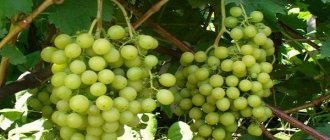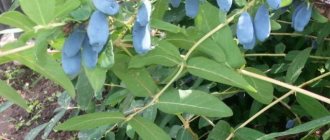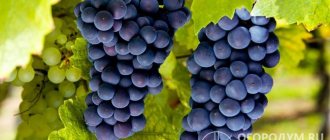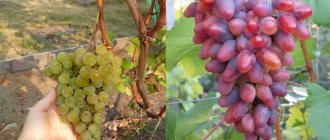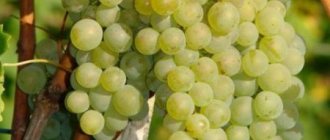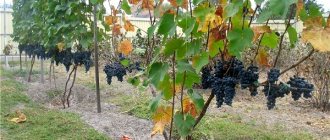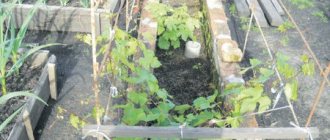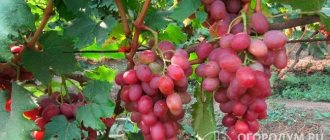Description of grapes
Botanical description of the Delight grapes:
- Bushes. Vigorous and spreading, with powerful shoots. Over the course of a year, the vine grows 2-2.5 m. The leaves are medium-sized, with jagged edges, light green, and shaped like a heart. The flowers are bisexual.
- Bunches. Large, moderately dense, varying in shape and size. There are conical, cylindrical, shapeless. Weight – from 0.5 to 2 kg.
- Fruit. Various sizes, oval-round. Size – 2.4x2.7 cm. Weight – 6-7 g. Color – depends on the variety (white, black, red). The skin is moderately dense.
- Roots. Powerful root system. The direction of the roots is vertical. They grow up to 2 m deep.
History of creation
The hybrid “Vostorg” was developed at the All-Russian Research Institute of Viticulture and Winemaking named after Ya.I. Potapenko." It was created according to the formula: (("Dawn of the North" x "Dolores") x "Russian Early"). It was this hybrid that was subsequently entered into the state register, where it received recognition as a variety.
There are varieties of the variety: “White Delight”, “Red Delight”, “Original Delight” and “Black Delight”. “Red”, “Original” and “Black” were created in parallel with “White” and differ from it only in terms of ripening and color. There are also other variations of this variety, which are produced almost annually by folk breeders.
What characteristics does Delight have?
The Vostorg grapes are considered one of the best varieties grown in Russia. The reason for this is high marketability and excellent agrotechnical characteristics.
Taste and marketability
The bunches are highly marketable - they are beautiful in appearance, retain their shape, do not wrinkle and do not deteriorate on the road. The brushes are moderately dense, so the berries do not crush or deform each other.
The taste of the berries is harmonious, the pulp crunches pleasantly. The fruits have a lot of sugar - 19-26%. The acidity is low - 5-9 g/l. Moderately dense skin, without impairing the taste, has a positive effect on the transportation of goods.
Productivity
“Vostorg” refers to high-yielding varieties - up to 120 centners of grapes are harvested from one hectare. Productivity is responsive to watering and fertilizing - they affect the quality and quantity of the harvest.
The bushes are productive - they have about 80% of fruit-bearing shoots, each of which produces 1.6 bunches.
Application
This is a white muscat variety. Belongs to the dining group. Possessing high taste characteristics, it is intended for fresh consumption.
Berries are not only tasty, but also healthy - they are rich in antioxidants and iron. They are used to make juices, jams, and wines.
Ripening time
The variety is early ripening - the fruits ripen in 110-120 days. The exact timing of ripening depends on the growing region. In the south, the bunches are ready at the end of July, in more northern regions - by mid-August.
Watch a review of the “Delight” grape variety in the following video:
Resistance to diseases and pests
The variety satisfactorily resists the most dangerous grape diseases - gray rot, oidium, mildew. “Vostorg” is resistant to fungi of any kind, but, like other grape varieties, it cannot do without preventive spraying.
The variety is helpless against phylloxera. This insect was brought from America. Areas infected with phylloxera are not used for grape planting for 20 years. Vaccination on a rootstock resistant to phylloxera, for example, “Riparia Kober 5BB” and “Berlandieri,” helps to escape from the overseas scourge.
There is no effective fight against phylloxera - if the insect infests, the bushes must be uprooted and destroyed.
Frost resistance
The variety is valued for its relatively high frost resistance. Bushes, even without insulation, tolerate frosts down to -25°C without losing productivity. The variety tolerates harsh winters well; it is successfully cultivated in central Russia, the Urals, Siberia, and the Far East.
Drought resistance
The variety tolerates drought well. A short absence of watering does not have a decisive effect on the formation of the crop.
Advantages and disadvantages
As many gardeners note, the advantages of the Delight grapes are much greater than the disadvantages. The advantages include:
- early ripening;
- a bountiful harvest;
- resistance to transportation;
- long shelf life;
- resistance to frost and drought;
- excellent taste;
- beautiful appearance of berries;
- the berries can hang on the vine for a long time and not spoil;
- cuttings take root well;
- high resistance to diseases in the presence of preventive treatment.
- weak resistance to root and leaf phylloxera;
- Rationing is required to obtain a good harvest.
Variety varieties
Breeders, inspired by the excellent agrotechnical characteristics of Delight, bred several of its varieties, differing in the appearance and taste of the fruit.
Dozens of varieties were created on its basis - Ecstasy, Elegant, Kesha, Sashenka and many others. But only 6 varieties had the name of the progenitor in their names. Let's take a closer look at the varieties of Delight grapes.
Muscat
Extra early table variety. Ripens in 105-110 days. Fruiting - in 2-3 years of planting. The ripening period in the middle zone is early August. The clusters are conical or shapeless, dense, weight - 0.4-1 kg. There are 2 bunches on one shoot.
The berries are round, white, and become amber when fully ripe. Weight – 7 g. Taste – nutmeg aftertaste. Sugar content – up to 25%. Resistant to fungi, affected by anthracnose, chlorosis and phylloxera.
Black
Known as the "Black Baron". Requires pollinators - it only produces female flowers. Early ripening, ripening period - 109-125 days. It bears fruit after 2-3 years of planting. The clusters are large and dense, weighing 0.8-2.5 kg. Productivity – up to 250 c/ha.
The fruits are large, weigh 7-12 g. Color – dark blue, to black. The shape is round, slightly elongated. Resistant to phylloxera, mildew, and oidium. Affected by gray mold. Sugar content – up to 26%.
White
Vegetation period – 115 days, yield – 120 c/ha. Ripening - mid-August to late September. The weight of the berries is 5-7 g. White and white-green fruits have a golden hue on the sunny side. The fruits are oval or round, sweet, juicy. Sugar content – 25%. Affected by phylloxera.
Red
Ripening occurs 120-130 days after flowering. Flowers are only female. Bisexual varieties are required nearby. The clusters are loose, conical, weight - 0.55-0.8 kg. Maximum – 1.5 kg. The shape of the berries is oval or nipple-shaped. Pink colour. Weight – 6-8 g. Juicy, tasty, meaty. Sugar content – up to 23%. Resistant to mildew, oidium, gray rot.
An overview of the “Red Delight” variety is presented in the video below:
Ideal
White table variety. Productivity – 120 c/ha. The clusters are sharply conical in shape and have wing-shaped branches. Weight – 1-1.5 kg, on large bushes – up to 2.5 kg. The berries have one small seed. Oval-round or nipple-shaped. Weight – 5-6.5 g. The pulp is juicy and crispy. Sugar content – up to 19%. Affected by phylloxera. Resistant to mildew and gray rot.
Baklanovsky (oval)
Ripens 115-125 days after bud break. The clusters are large, conical, dense, weight - 0.65-0.9 kg. The fruits are oval or nipple-shaped, large, white, weighing 6-7 g. In the sun they acquire a golden tan. The pulp is juicy and crispy. Sugar content – up to 23%. Resistant to mildew, gray rot and oidium. Almost not damaged by wasps.
The grape variety “Oval Delight” is presented for review:
Protection from diseases and pests
Vostorg grapes are considered very resistant to gray rot and mildew.
It is less affected by spider mites and oidium. For many vineyards, powdery mildew and phylloxera are the scourge. Therefore, it is necessary to carry out preventive protective work to protect the plantings. Spraying with a sulfur-containing solution is carried out several times during the growing season. This product perfectly eliminates mites at all stages of its development, and also destroys fungal spores. If desired, solutions of insecticides and fungicides can be used. And experienced farmers experiment with rootstocks, using varieties that are most resistant to pests and diseases.
Pros and cons of Rapture
Advantages of Delight grapes:
- high productivity;
- large bunches;
- rapid growth of vegetative mass;
- moderate immunity to major grape diseases;
- high frost resistance;
- pleasant taste and aroma of nutmeg;
- the fruits, when ripe, remain on the bushes for 1-1.5 months;
- transports and stores well;
- propagated by cuttings - rooting is satisfactory;
- many fruiting shoots;
- Possibility of decorative use.
Flaws:
- the variety is affected by phylloxera;
- the bushes tend to be overloaded with the harvest - rationing of the bunches is necessary.
Landing Features
To give the grapes a good start, it is important to plant them correctly. First, a suitable site is selected, the soil and planting material are prepared, and then the seedlings are planted - in full compliance with planting techniques.
When does planting work begin?
Planting of seedlings is carried out:
- In autumn. Experienced winegrowers believe that planting in autumn is more suitable for this frost-resistant variety. In the fall, you can both plant seedlings with a root system and graft cuttings. Young animals tolerate their first winter well with additional shelter.
- In the spring. With this planting, the seedling has time to take root well and become stronger before the onset of winter. But in this case, you have to care for the seedlings immediately after planting - regular watering is especially important.
Selection and preparation of a landing site
Optimal conditions for the site:
- south or southwest side of the site;
- there should be no shading by buildings or plantings;
- absence of drafts and northern blowing winds;
- soil – chernozem or loose loam;
- groundwater level – from 2.5 m.
Wetlands and places where cold air stagnates are strictly unsuitable.
The soil is regularly fertilized with organic matter and mineral fertilizers for two years before planting. The area intended for planting grapes is prepared in advance. For spring planting, it is advisable to prepare the soil and holes in the fall. For autumn planting - a few weeks before the process.
First, the area is cleared of weeds, uneven areas are leveled, and rotted manure is spread. The thickness of the manure layer is 10 cm. The soil is dug 70-80 cm deep. If the soils are acidic, they are deoxidized with wood ash; if they are heavy clay soils, sand is added.
Selection and preparation of seedlings
It is recommended to buy seedlings from specialized nurseries - this reduces the risk of infection of planting material with fungal and viral diseases.
When choosing seedlings, pay attention to the following signs:
- roots are fresh and elastic;
- root section - white;
- the cut of the top is green.
Before planting, the roots of the seedling are kept for several hours in a Heteroauxin solution (200 ml per 1 liter of water).
Step-by-step instructions for planting
The procedure for planting seedlings:
- Dig holes for planting, maintaining an appropriate interval between them. The planting scheme depends on the size of the seedlings. Medium-sized ones are planted at intervals of 4 m, and 6 m are left between vigorous-growing ones. Dig holes in the form of a cube with a side of 80 cm.
- Pour drainage into the bottom - pebbles, crushed stone, broken brick. Install a drainage pipe and support for the seedling.
- Pour a bag of humus into the bottom of the hole, add wood ash superphosphate and a mixture of fertile soil and sand. The roots of the seedling should not touch fertilizers.
- Place the roots of the seedling on fertile soil and spread them evenly in all directions. Place the seedling so that its root collar is 3-4 m above ground level.
- Cover the roots with fertile soil and compact them tightly so that there are no voids.
- Pour several buckets of water at room temperature under the root. Mulch the tree trunk circle with peat or humus.
Care after landing
Immediately after planting, the seedlings are watered abundantly, and after that they do not need to be moistened often. Watering through a drainage pipe is usually sufficient.
The soil around the seedling is mulched after each watering to conserve moisture. The grapes will not need fertilizing in the first year - the fertilizers applied during planting will be enough for just a couple of years of active growth.
Growing
You can grow Delight and Arcadia both from grafted seedlings and from your own roots. If a vineyard is planted over large areas, it is better to use grafted young plants. You need to purchase them from specialized nurseries. This guarantees that the seedlings will be exactly those that you would like to plant on the site, and not some wine variety. Money will be lost, and most importantly, time. Because only in the second year, when the first berries appear, can you understand your mistake. You can’t plant grapes and forget about them for a long time. Each year you will need:
- Trimming;
- Dry garter;
- Catarovka, stepsoning;
- Feeding;
- Irrigation;
- Disease and pest control.
When choosing planting material, you should pay attention not only to the vine and leaf, but also to the root system.
It is best to use drip systems for irrigation. This is economical and, in addition, it is not the entire area that is watered, but a specific area.
Planting period
Saplings of the Monarch variety, like any other, can be planted in autumn and spring. Before this, they need to be soaked for 2-3 days. When choosing planting dates, you need to pay attention to the following aspects:
- Planting in spring . The bush adapts well, strengthens itself, and gains strength for the winter. But in this case, the plantings will have to be watered more often, and before the onset of cold weather, the plants must be well covered for the winter;
- Planting in autumn. If the plants are carefully covered, they will overwinter well, especially since the variety is frost-resistant, and with an increase in soil temperature they will immediately begin to grow.
One of the important conditions for planting is that the place must be fully illuminated by the sun. Grapes don't like shade. As, indeed, is waterlogged soil. Read about planting and caring for virgin grapes here.
Slopes and hills are some of the best places, as they are sheltered from the winds and windproof.
Delight grows well on sandy loam, chestnut and chernozem soils.
Ripening period
Delight is an early variety. The first ripe berries can be tasted already on the 105th day after bud break. And after a week or two, the massive harvest begins.
Due to the fact that there are several types of this variety, their ripening times are slightly different:
The earliest to ripen is Muscat Delight (100–110 days). Black Delight ripens a little later (110–120 days). But red grapes and Perfect Delight ripen a little longer (after 130 days).
Harvesting takes place in mid-August, but the ability of this species to ripen on the bush for a long time allows the grapes to “hold out” until September.
The grapes are easy to use and transportable. If it is not possible to collect it on time, then it can remain on the bushes for a very long time without losing its presentation.
Features of vaccination
Cuttings with 2-3 eyes are grafted. Planting material is selected that is healthy, dry, with a green cut. To ensure that the cuttings retain moisture, their upper part is covered with paraffin - dipped into melted paraffin for a few seconds.
For better survival, the lower part of the cutting - the part that is to be lowered into the split on the rootstock - is cut off on both sides. Before grafting, this end of the cutting is kept in water for a day or two. It is useful to immerse the cut part of the cutting in a solution of “Humate” - a root growth stimulator.
Preparation of the rootstock:
- The old grape bush will serve as the rootstock. Cut it down, leaving a stump 10 cm high.
- Clean the surface of the stump.
- Split the stump and prepare a slit for inserting the cutting. Do not split the stump deeply to avoid damaging the rootstock. If the width of the trunk allows, you can make several splits in it - for several cuttings.
- Place the cutting into the split and clamp it firmly. Coat the grafting site with clay. A strong clamp increases the chances of survival.
- Near the rootstock, dig a support for the bush. Water generously and mulch the soil.
Care of newly grafted grapes
Features of caring for a grafted bush:
- Loosening the soil to improve soil aeration and survival of cuttings. Grafting into a split trunk should not be covered with soil at the junction of the scion and the rootstock.
- After 15-20 days, the grafting is checked - if there are no shoots, the procedure is repeated, cutting off the rootstock below the split.
- Every two weeks they check how the fusion process is going. Roots that protrude and do not grow into the rootstock must be cut off. If you don't do this, the roots will grow into the ground. In essence, this will be planting in the soil, not grafting.
If the grafting was done in the fall, then before frost the scion and rootstock are covered with spruce branches or dry grass.
If grafting is carried out correctly, the harvest on the new bush will appear in 1-2 years.
Agrotechnical features during the growing period
The Delight variety is not a demanding or capricious variety. To get a full harvest, it is enough to follow simple agricultural cultivation techniques.
Watering
The Delight variety does not require abundant moisture. Moreover, it easily copes with droughts. The rate of watering depends on the weather, the age of the bushes, and the water permeability of the soil. The average watering rate for one seedling is 10-15 liters.
Approximate watering schedule:
- early spring;
- before flowers bloom;
- during the ripening of bunches;
- at the end of October - moisture-recharging irrigation.
The frequency of watering depends on the weather and the growing season. Plants will need additional watering around June - before and after flowering. Watering should be stopped 2-3 weeks before harvesting.
Feeding
In the second year of life, young grapes should be fed. The Vostorg variety is responsive to fertilizers - they affect its yield.
The order of fertilizing is presented in the table:
| Period | Composition and standards |
| Spring. Before flowering. | Fertilizers are applied before flowering, when the bush begins to grow intensively. Nitrophoska (50 g) and boric acid (0.4 g) are dissolved in 10 liters of water. Thanks to this composition, the ovaries and inflorescences are strengthened and their shedding is prevented. |
| 2-2.5 weeks after the first | The composition is similar to the first feeding. |
| Before fruit ripening | Dissolve nitrophoska (25 g) and potassium salt (1 tbsp) and potassium magnesia (1 tbsp) in a bucket of water. Potassium mineral fertilizers can be replaced with wood ash. |
Dry fertilizers cannot be applied to the soil - the root system can get burned.
Trimming
The bushes of the Delight grapes are vigorous and require short pruning. Delight, like other table varieties, bears fruit mainly in the lower part of the vine. In Vostorg, unlike other varieties, they leave not 1-2 eyes, but 3-4. This move takes into account the possible death of the vine in winter.
Principles of pruning:
- No more than 45 eyes are left on the bush.
- Before flowering, the tops of the shoots are pinched.
- 20-25 shoots are left on one bush
Pest treatment
The variety is characterized by average resistance to the main diseases of grapes - mildew and oidium. But the main danger to Delight is represented by pests - grape aphids and phylloxera. The variety requires mandatory preventive spraying.
Principles of pest control for Vostorg grapes:
- The best remedy for powdery mildew (oidium) is treatment with sulfur vapor. It is recommended to spray bushes with sulfur in warm and dry weather. Oidium is especially dangerous in hot years, when summer temperatures rise to +30°C.
- To prevent powdery mildew, remove excess leaves and shoots - the bushes should be well ventilated.
- All above-ground parts showing signs of powdery mildew are immediately cut off and destroyed.
- Phylloxera is combated by spraying the bushes with Lindane (insecticide) or carbon disulfide. The lethal dose of carbon disulfide is 300-400 cubic meters. cm per 1 sq. m. But such a dose is also harmful for the bush, so they take 70-90 cubic meters. cm.
- Leafworms are controlled by spraying with insecticides.
- Sticky baits are installed against wasps, and the bunches are covered with mesh bags.
Wintering
Delight is a frost-resistant variety. It belongs to the non-covering group. But you shouldn’t risk young seedlings - they need to be covered in the first winter. Especially if they are planted in the fall.
A structure in the shape of a vessel is made over the seedlings. They fill it with sand, and throw spruce branches and moss on top. If the seedlings can be bent down, then the vine is secured to the ground with staples. Cover the top with spruce, peat, moss, and straw. Snow is thrown over the shelter.
Care
Delight does not require any very serious care efforts from the winegrower. But at the same time, it responds well to watering and fertilizing with mineral or organic fertilizers. But it can easily tolerate short-term lack of moisture.
Ammonium nitrate can be used for fertilizing only during the beginning of the growing season.
It is also necessary to keep the vineyards clean by removing weeds.
Mulch the soil near the bush. But in early spring or autumn it is necessary to prune the bush correctly. The berry harvest depends on the load. And also throughout the entire growing season, preventive treatments of plants should be carried out in order to prevent infection with fungal diseases.
Disease Prevention
Delight not only has beautiful berries and clusters, but in addition it is resistant to some fungal diseases. For example, mildew, gray rot. This applies more to Rapture red. But white, nutmeg does not resist oidium very well. Delight is unstable against phylloxera. The Attica variety is resistant to phylloxera disease. Grape aphids feed not only on leaves and shoots, but do not disdain the root system of the plant. This is a quarantine disease and now it almost never occurs. But if a pest appears, the bush must be destroyed. Preventive measures will not hurt against fungal diseases. It will be enough to treat the bushes with a solution of Bordeaux mixture. The first time this can be done is in the fall, after the leaves have fallen off. And the second - before the buds open. A good preventative antifungal drug is Ridomil Gold.
Preventive measures should not be neglected. Because in case of prolonged rains and cool temperatures, infection with fungal diseases is possible.
Trimming
The yield of grapes is influenced by high-quality pruning of bushes. The load on the Voskhod grape bush should be in the range of 35–45 buds. The fruitfulness of the buds is highest at the base of the shoots. Therefore, they can be cut short, leaving 2-4 eyes. You will get very large clusters if you leave 20–30 eyes on the bushes. Delight shoots usually ripen well. But again, each type of Rapture should be loaded slightly differently:
- Black. Doesn't like thickening. Leave up to 50 eyes per bush. And on the shoot - up to 12. Short pruning with 3-4 eyes is also practiced.
- Red. Leave up to 25 shoots. Each shoot has 10–15 buds.
- Nutmeg. Responds better to short pruning. Underdeveloped shoots are cut out.
Reviews of grapes Delight
★★★★★
Perechnikov V.I., Tula region. I've been growing Delight for about 15 years. This variety never lets me down - it ripens under any circumstances.
I've never seen him get mildew. I experienced spring frosts twice, many varieties were damaged, but Vostorg had no problem. I cover it for the winter - I don’t risk my favorite variety. ★★★★★
Elena P., Moscow region. Delight is a hardy variety with tasty fruits.
The berries are sweet regardless of the summer weather. The variety is frost-resistant, but if it freezes slightly, it is difficult to recover. Therefore, I cover it for the winter - I make a primitive shelter from spunbond. Hide
Add your review
When naming a new grape variety, breeders probably counted on rave reviews from amateur gardeners and professional winegrowers. And they were not mistaken - the Vostorg grape is rightfully considered one of the best domestic varieties - tasty, hardy, winter-hardy.
0
0
Copy link
Reviews from gardeners
Mikhail, 32 years old, Nikolaev region
Delight is ideal for our region - early ripening, berries are golden-amber in color, the taste is sweet and pleasant, and the flesh is tender with a thin skin that cannot be felt when eating. It tolerates prolonged rains calmly - the berries do not crack and there have never been any fungal diseases. Despite the fact that the bushes froze last winter, they “reanimated” well at the beginning of July. I don’t want to take any more risks and from this year I will cover it with spunbond for the winter.
Ekaterina, 45 years old, Odessa
The seedling planted on the site did well. During the season I produced two vines of approximately 1.5 meters each. In the spring I shortened them to a meter. As soon as the buds began to grow, inflorescences appeared in each of them, from the very bottom to the top of the vine. I have never seen this on any other grape. The variety is simply amazing and fully lives up to its name!
Igor, 61 years old, Krasnodar region
At my dacha, “White Delight” is probably the only variety of all the varieties I know that has not disappointed me over many years. The grapes are responsive to timely watering and respond normally to increased doses of mineral and organic fertilizers. It is practically not affected by anthracnose, unlike the three “Isabella” bushes growing on my site. Wasps are absolutely indifferent to it. Our whole family really likes the taste of the berries for their sweetness and independence from the weather, as opposed to “Augustine” and “Timur”. This summer, due to departure, part of the harvest was collected on July 25th. A considerable number of ripe grapes had to be left on the vine. They were perfectly preserved in perfect condition almost until October 5th. Unfortunately, I only have one bush of this real “miracle”. Initially, when planting the vineyard, Delight took root the worst of all, at one time he even wanted to uproot it. In practice, it turned out that he is the best, and every year I appreciate him more and more.
